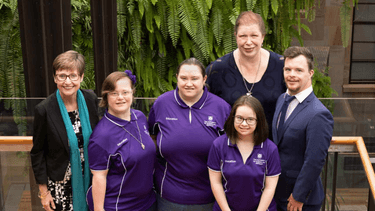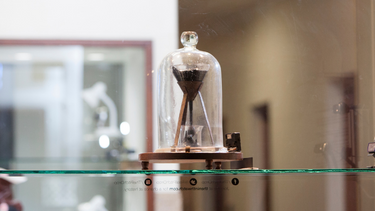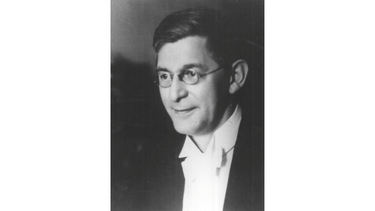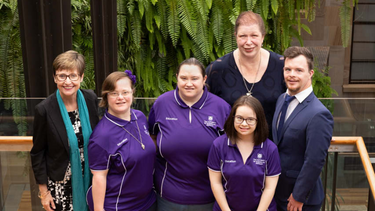What are UQ’s longest running research projects?

Sponsored by

As the saying goes, if something’s worth doing, it’s worth doing properly. At UQ, some researchers have given this saying new meaning, setting up experiments and research programs that have run for decades, and in one case almost a century!
This Research Week, discover some of UQ’s longest-running projects, from a world-record physics experiment to studies that have redefined women’s health.
Pitch drop
In the foyer of the Parnell Building on the St Lucia campus, sits a curious-looking display. Under an old-fashioned glass dome, a shiny black substance sits in a funnel suspended over a beaker – looking poised to drop at any moment, but seemingly never moving.

The black substance is pitch, a derivative of tar that is actually the world's thickest known fluid – 100 billion times more viscous than water.’
At room temperature pitch feels solid – even brittle – and can easily be shattered with a hammer.
Thomas Parnell, UQ's first Professor of Physics, created the experiment in 1927 to illustrate that everyday materials can exhibit quite surprising properties.

Professor Thomas Parnell, who set up the study in 1927
Professor Parnell cut the tip of the funnel in 1930 and the first drop fell eight years later. The most recent drop fell in 2014. Incredibly, no one has ever witnessed this occur.
Today, the experiment holds the Guinness World Record as the longest-running laboratory experiment and is maintained by Professor Andrew White.
Discover more about this historic experiment
Hypersonics
Every now and then news emerges about the possibility of a flight from Sydney to London in four hours. It might sound fantastical, but the hypersonic technology behind these stories is very real and has been studied at UQ for more than 40 years.

Launch of the BoLT II rocket launch from the NASA Wallops Flight Facility in Virginia on 21 March, 2022
Professor Ray Stalker AO joined UQ in 1977 and founded the largest program in hypersonics and space propulsion in the southern hemisphere. Together with UQ’s Professor Richard Morgan, he started conducting the first experiments at the T3 ground test facility at ANU. Later, they developed the T4 ground test facility at UQ – the first facility in the world capable of both simulating the range of flight speeds needed for scramjet development and measuring their performance.
Since then, the Centre for Hypersonics has gone onto achieve a number of firsts, including the world’s first atmospheric test of a scramjet in 2002.
Read about UQ’s role in the Boundary Layer Turbulence Flight Experiment (BoLT II), a milestone in hypersonic technology research.
Down Syndrome research
In 1978, researchers at The University of Queensland recruited a group of babies with Down syndrome for a world-first study that would follow their health and development from infancy to adulthood.
The study coincided with the end of a practice in Australia that routinely saw these children institutionalised. The program therefore set out to follow the first generation of people with Down syndrome to be cared for by their families, educated at school, and eventually living in the adult community.
The Down Syndrome Research Program (DSRP), based at UQ’s School of Education, has now been running for more than 40 years. It has debunked many myths about Down syndrome and led to the development of programs that are not only improving and enriching the lives of the people who took part in the study, but people with intellectual disabilities around the world.
The project broke new ground in 2022, when UQ hired four adults with Down syndrome as research assistants in a new study exploring the quality of life of Gen Zs (18–30 year olds) with Down syndrome).

Find out more about the project
Australian Longitudinal Study on Women’s Health
Over the past 25 years, more than 57,000 women’s lives have been touched by the Australian Longitudinal Study on Women’s Health (ALSWH).
In 1996, researchers recruited three cohorts of women – the first group born in 1921–26, the second in 1946–51, and the third in 1973–78. In 2013, a new cohort of women born in 1989–95 were added to the study.
The women are surveyed at regular intervals on everything from chronic conditions to social factors and the impact of natural disasters.

The study has made some incredible discoveries, including:
- Women who get their first period before the age of 11 are 50 per cent more likely to experience frequent hot flushes and night sweats during the menopause transition.
- Use of cannabis in the years before pregnancy increases a woman’s risk of post-natal depression. And a healthy diet before pregnancy can reduce the chance of children having behavioural problems.
- Women born between 1989 and 1995 are eating more fruit and vegetables than their older peers did at the same age and they’re getting just as much exercise, but their general health is worse, their rates of obesity are far higher, and their mental health is much worse than their older peers at the same age.
The surveys have captured hundreds of millions of data points, which have been analysed in more than 1,000 publications by over 1,500 researchers from around the world.